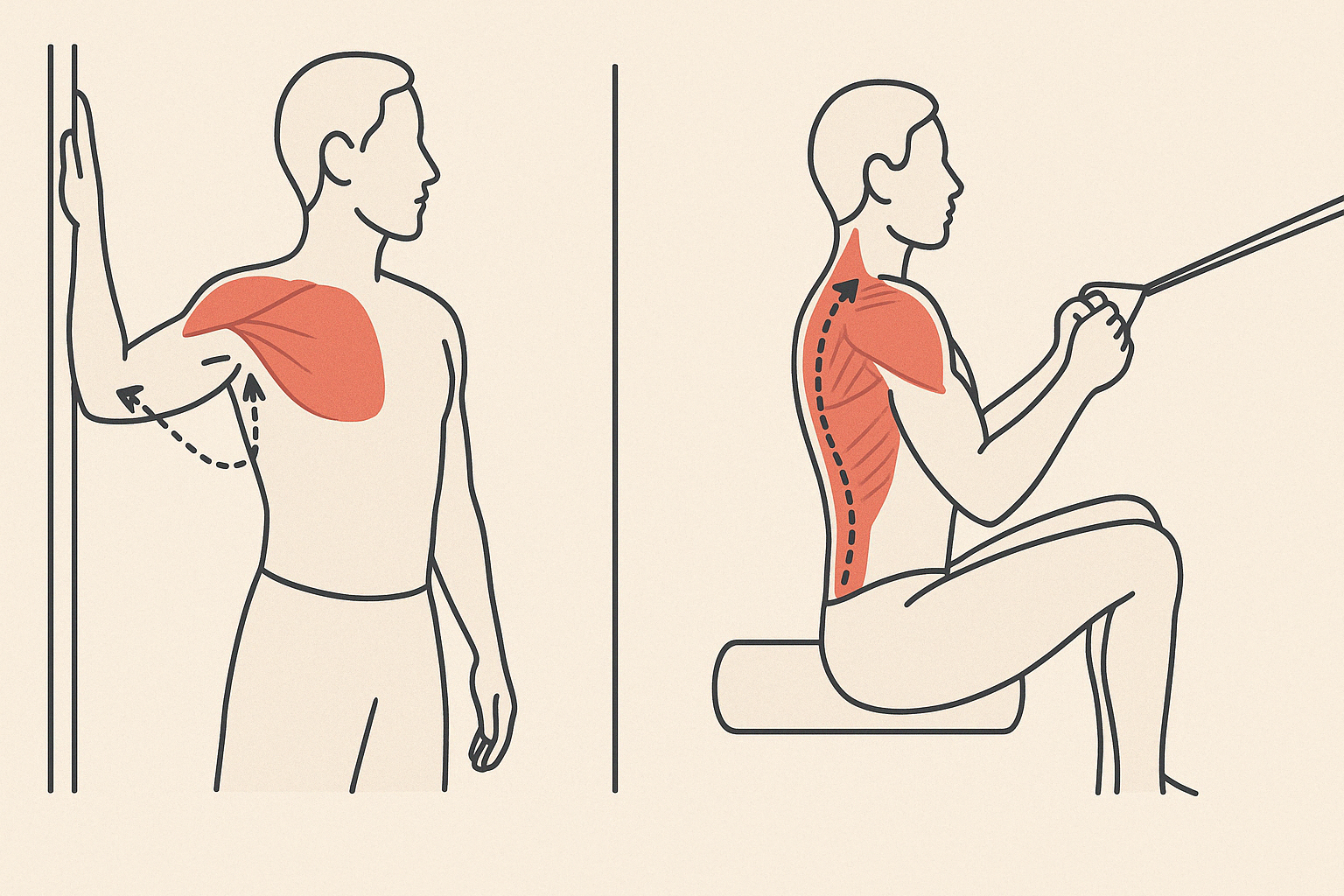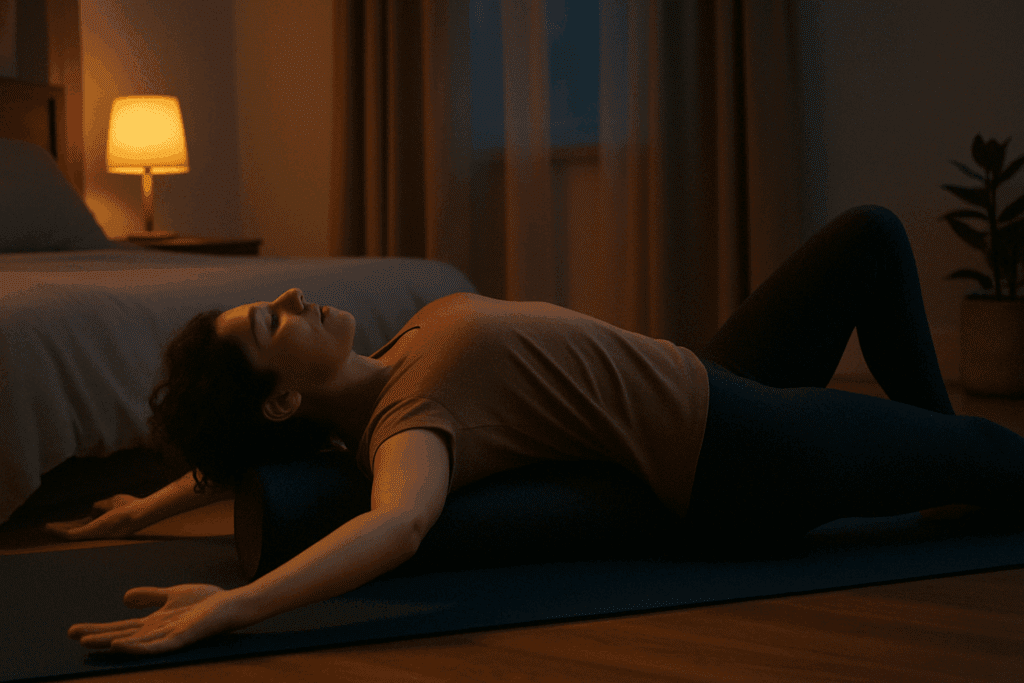Introduction: Why Chest Flexibility Matters More Than You Think
Chest stretches are more than just warm-ups or cool-down routines. In today’s increasingly sedentary culture, where many people spend long hours hunched over desks or staring at screens, the pectoral muscles are often neglected in mobility training. The result is not only reduced flexibility but also compromised posture and increased susceptibility to musculoskeletal pain. Knowing how to stretch chest muscles properly can improve everything from how you carry yourself to how deeply you breathe. For athletes and casual exercisers alike, incorporating stretching exercises for chest health is vital to promoting muscular balance, enhancing athletic performance, and preventing injuries.
You may also like : Best Stretches for Sore Legs and Tight Thigh Muscles: How to Relieve Upper Leg Pain Safely and Naturally
Understanding the role of the pectorals—which include the pectoralis major and pectoralis minor—is essential for developing an effective chest stretching routine. These muscles are involved in virtually every upper-body movement, from pushing a door to lifting weights. Tight pecs can restrict shoulder motion, strain the neck and back, and even contribute to tension headaches. Pectoral stretching exercises can alleviate these issues while also enhancing the visual symmetry of the upper body. Whether you are looking for post chest workout stretches or simply want stretches for chest pain relief, the benefits of chest mobility are significant and far-reaching.

The Anatomy of the Chest: Understanding What You’re Stretching
Before diving into the best chest stretches, it helps to understand the muscular architecture you’re targeting. The pectoralis major is the large, fan-shaped muscle covering much of the upper chest, responsible for actions such as adduction, flexion, and internal rotation of the humerus. Underneath it lies the pectoralis minor, a smaller muscle that assists in stabilizing the scapula. Both muscles can become shortened from activities that involve forward-reaching or internal shoulder rotation, such as typing, driving, or bench pressing.
When you perform chest opening exercises, you aren’t just improving the elasticity of muscle fibers. You are also influencing connective tissues like fascia, tendons, and ligaments, all of which contribute to joint mobility. Tightening chest muscles over time can lead to compensatory patterns throughout the upper kinetic chain. That means if your pecs are tight, your shoulders might round forward, your thoracic spine could lose mobility, and even your breathing may become shallow. Understanding this muscular interdependence underscores the value of regularly practicing mobility exercises for chest health.

Fascial Restrictions and Myofascial Release for the Chest
One often overlooked aspect of chest mobility is the role of fascia—the connective tissue web that surrounds and integrates muscles, bones, and organs. Tight pectoral muscles are frequently accompanied by fascial adhesions that resist traditional stretching. This is where myofascial release techniques can offer profound benefits.
Self-myofascial release using tools like massage balls, foam rollers, or vibrating spheres can target the deeper fascial layers around the sternum, clavicle, and shoulder joint. These tools are especially effective for those with persistent tightness who feel that standard chest opening exercises are no longer producing results. Releasing fascial tension before stretching exercises for the chest can improve range of motion and reduce pain.
Additionally, manual therapy from a trained practitioner—such as a physical therapist or sports massage specialist—can address fascial limitations that are not easily accessible through self-treatment. Combining manual release with chest static stretches can restore movement quality more efficiently than stretching alone. For individuals recovering from injury or surgery, fascial work may be essential to reestablish tissue pliability and reduce scar-related movement restrictions.
How Chest Tightness Affects Posture, Breathing, and Pain
If you’ve ever felt a sense of tightness across your chest or noticed your shoulders rounding forward after a long day at a desk, you’re experiencing the consequences of limited pectoral mobility. Chronic tightness in the chest muscles pulls the shoulders inward and down, distorting the natural curvature of the spine and contributing to postural dysfunction. This imbalance often manifests as upper back or neck pain, particularly when the scapular stabilizers become overworked trying to compensate for inactive or shortened pecs.
Additionally, chest wall stretching can facilitate deeper, more diaphragmatic breathing. Tight pecs can restrict rib cage expansion, limiting the volume of air you can draw into your lungs. This restricted breathing can influence your overall energy levels and even your mental focus. For people experiencing non-cardiac chest discomfort, targeted stretching exercises for chest pain may relieve symptoms by reducing myofascial tension and promoting better blood flow to the area.
Posture is more than aesthetics; it is a reflection of musculoskeletal health. Stretches for chest tightness can help undo years of poor alignment habits, whether developed through desk jobs or intense upper-body training. By incorporating regular sternum stretch techniques and static stretching for the pecs, individuals can retrain their bodies to find balance and reduce long-term injury risk.

Chest Stretches in the Context of Functional Movement Patterns
One of the reasons chest mobility often breaks down is due to poor integration into full-body movement patterns. While isolated stretches are beneficial, training your body to use its new range of motion in dynamic contexts is what solidifies lasting change. This is particularly important for those interested in functional fitness or rehabilitation.
Incorporating stretches for pecs into compound movements like wall angels, Turkish get-ups, or dynamic spinal rotations can train the nervous system to retain flexibility during real-world movements. Exercises like deep lunge reaches with overhead extensions open both the chest and hip flexors, creating cross-sectional tension release that benefits total body alignment.
Training for functional movement also encourages what is known as reciprocal inhibition—activating the antagonistic muscles (like the rhomboids and lower traps) to help relax the pectorals. This neurophysiological principle can make pectoral stretching exercises more effective. For example, performing a scapular retraction drill before a sternum stretch can “prime” the neuromuscular system to release the anterior chain more fully.
The Influence of Breathwork on Chest Mobility and Recovery
Chest stretches and breathing exercises share a common foundation: the thoracic cavity. Restriction in chest musculature directly impacts the ability to perform full, diaphragmatic breathing. Conversely, shallow breathing can exacerbate muscular tightness by perpetuating stress-induced tension.
Integrating breathwork into chest opening exercises transforms them from purely mechanical movements into holistic neuromuscular experiences. Deep nasal inhalations followed by long, controlled exhalations stimulate the parasympathetic nervous system, enhancing relaxation and allowing deeper muscle release. This is particularly helpful in post chest workout stretches, where the goal is to transition the body from exertion into recovery.
One particularly effective practice is box breathing during pectoral stretching: inhale for four counts, hold for four, exhale for four, and pause for four. Doing this while holding a doorway pec stretch can increase both mental focus and physiological tissue release. When paired with consistent stretching exercises for chest pain relief, breath-focused mobility work can significantly improve both physical and emotional well-being.

Chest Stretches for Special Populations: Aging Adults, Pregnant Women, and Post-Rehab Patients
While many chest stretches are promoted within athletic or fitness circles, special populations have unique needs that make pectoral stretching even more essential. For older adults, thoracic rigidity and forward-flexed postures are common contributors to falls, respiratory compromise, and chronic back pain. Gentle stretching exercises for the pectorals, performed with assistance or seated, can improve posture and breathing capacity, which are foundational to healthy aging.
Pregnant individuals often experience a shift in posture due to abdominal expansion and weight distribution changes. This can tighten the chest and contribute to mid-back pain. Carefully adapted chest opening exercises can help mitigate these issues while improving overall comfort. Wall-supported stretches or foam roller openers are safe and effective when performed under supervision.
For those recovering from surgeries such as mastectomies, shoulder repairs, or cardiac procedures, stretching the chest must be done progressively and often under professional guidance. In these cases, even basic mobility exercises for chest flexibility must be adapted to the individual’s healing timeline and pain tolerance. Nonetheless, pectoral stretching is an integral part of regaining function and confidence post-rehabilitation.
Best Chest Stretches You Can Do Anywhere
Incorporating the best chest stretching exercises into your daily routine doesn’t require a gym or even much space. Many of the most effective chest stretches can be performed using a wall, doorway, or even while seated. For those wondering what exercises stretch your pecs most effectively, the key lies in consistency and form. Begin with static stretches held for 20 to 60 seconds, especially post chest workout stretches when the muscles are warm and pliable. Gradually increase duration and intensity to improve flexibility over time.
A classic stretch to begin with is the doorway pec stretch. Standing in a doorway with your arms braced against the frame at shoulder height or slightly higher, gently step forward until you feel a stretch across the front of your chest. Hold the position without bouncing. This stretch targets both the pectoralis major and minor, depending on the height of the arm placement. Another effective movement is the corner wall stretch, where you face into a corner, place your forearms on each wall, and lean your body forward. This variation provides a gentle but comprehensive chest wall stretching experience.
For individuals with particularly tight shoulders or those seeking stretches for chest pain, the lying chest opener with a foam roller can be transformative. Lie lengthwise on a foam roller so it supports your head and spine, then allow your arms to relax out to the sides in a T position. The stretch not only opens the pecs but also promotes spinal alignment. If you’re performing chest stretches before workout sessions, consider dynamic variations such as arm circles or wall slides to activate and prepare the muscles for movement.

Chest Stretches for Athletes and Lifters
Strength athletes, especially those focused on the bench press or overhead lifts, often experience shortened chest muscles due to repetitive pushing movements. Without balancing these motions with stretching exercises for pectoral muscles, the risk of shoulder impingement and other overuse injuries increases. In this context, pectoral stretching exercises serve both as a recovery tool and a performance enhancer.
A favorite among lifters is the banded doorway stretch, which provides added resistance to help deepen the stretch and engage stabilizing muscles. Anchoring a resistance band at chest height and stepping forward creates a more active stretch, ideal for athletes needing greater intensity. This is also a great example of chest static stretches with added proprioceptive feedback, allowing for greater muscle awareness and control.
Stretches for pecs following heavy upper-body days can significantly reduce delayed onset muscle soreness (DOMS) and maintain range of motion. Incorporating post chest workout stretches into your cool-down sequence helps flush metabolic byproducts and restores tissue elasticity. For best results, combine stretching with deep breathing techniques to enhance relaxation and circulation.
The Psychological and Emotional Benefits of Chest Opening Exercises
Stretching the chest is not only a physical practice—it can also be profoundly emotional. Somatic therapists and yoga practitioners have long observed that chest opening exercises may release stored emotional tension, particularly grief or anxiety. This connection is often attributed to the heart chakra in Eastern traditions or to the vagus nerve’s anatomical proximity in Western models.
Physiologically, opening the chest facilitates deeper breathing, which in turn calms the autonomic nervous system. Emotionally, it can evoke a sense of openness, vulnerability, and release. Practicing mindful chest stretches with slow breathing can help individuals process emotions they may not even have realized were stored in the body.
This is one reason why practices like yin yoga or restorative poses that include long-held stretches for chest tightness can be incredibly therapeutic. Supported fish pose, where a bolster is placed along the spine to gently open the chest, is often cited by practitioners as both physically rejuvenating and emotionally cathartic. Integrating chest stretching with mindfulness practices can elevate the experience from merely corrective to transformational.
How to Stretch the Pectoral Muscles Safely and Effectively
Effectiveness in stretching comes down to precision, patience, and posture. Knowing how to stretch the pectoral muscles safely ensures that you reap the benefits without risking strain or injury. It is crucial to avoid overstretching or forcing a stretch beyond your current mobility range. Stretching should never cause pain—only a mild to moderate sensation of tension.
One key element of safe chest stretches is scapular positioning. Before initiating a stretch, gently retract your shoulder blades to stabilize the scapulae and isolate the pecs. This technique minimizes compensation from surrounding muscles and allows for a more targeted stretch. Whether you are doing chest opening exercises or mobility exercises for chest flexibility, keeping your core engaged and your neck relaxed will improve both effectiveness and safety.
Gradual progression is also vital. Beginners should start with low-intensity stretches and hold them for shorter durations, slowly increasing as flexibility improves. Regularly changing the angle and direction of a stretch helps address all fibers of the pectoralis major and minor. Over time, integrating these good chest stretches into a weekly regimen can yield measurable improvements in range of motion and posture.

Chest and Back Stretches: Why Balanced Mobility Matters
Focusing solely on the chest without addressing the opposing muscle groups can create imbalances that undermine progress. The muscles of the upper back—particularly the rhomboids, trapezius, and posterior deltoids—act as natural antagonists to the pectorals. When the pecs are tight and the back muscles are weak or neglected, it exacerbates poor posture and limits shoulder function.
Integrating chest and back stretches into your routine promotes muscular harmony and joint stability. For example, pairing a sternum stretch with a thoracic spine extension can dramatically improve upper-body alignment. Similarly, combining a doorway chest stretch with a banded face pull activates the posterior chain while elongating the anterior. These combined movements not only alleviate tension but also enhance proprioception and control.
Stretches for chest day should always include complementary exercises for the back to ensure holistic mobility. This approach is particularly effective for individuals with chronic tension or pain stemming from prolonged sitting or poor ergonomics. When practiced consistently, stretching exercises for chest and back health can reduce injury risk, optimize breathing mechanics, and support functional movement patterns.
Practical Tips for Integrating Chest Stretches Into Your Day
Finding time for mobility training often seems like a challenge, but chest stretches can be seamlessly incorporated into daily life. Whether you’re at home, at work, or at the gym, a few minutes spent on stretching exercises for chest flexibility can yield long-lasting benefits. Begin by anchoring your routine around existing habits, such as stretching during a lunch break or after brushing your teeth in the evening.
Keep your environment in mind. Doorways, walls, and even chairs can serve as effective props for performing the best chest stretches. For example, placing your forearm against the corner of a wall while twisting your torso gently away can be done discreetly in an office setting. Even seated sternum stretch movements, where you clasp your hands behind your back and lift your chest upward, can be performed while working at a desk.
Frequency matters more than intensity. Performing moderate stretches for the pectorals several times a week will deliver more sustainable results than an occasional intense session. Always prioritize form and breathing over depth, as this fosters neuromuscular relaxation and safer range-of-motion gains. Those with persistent tightness or discomfort should consider consulting a physical therapist or movement specialist to personalize their routine.

Chest Stretching for Better Sleep, Better Posture, and Better Life
The benefits of stretching exercises for chest flexibility extend beyond the gym or yoga mat. One often underappreciated outcome is improved sleep quality. Tight pecs and forward-rounded shoulders can make side or stomach sleeping uncomfortable, leading to tossing and turning that disrupts rest. Regular stretching reduces tension and facilitates spinal alignment, both of which promote deeper, more restorative sleep.
Better posture is another lasting benefit. By routinely practicing good chest stretches, individuals begin to naturally carry their bodies with greater alignment and confidence. This can influence everything from how you walk into a room to how you perform under pressure, both physically and emotionally. It is no exaggeration to say that opening the chest can help open the mind.
Finally, chest and back stretches improve the functional capacity for daily activities. Reaching overhead, pushing open a door, or carrying groceries all require a synergy between the pectorals and surrounding musculature. Mobility exercises for chest and back help ensure that these everyday tasks are performed with less strain and greater ease, contributing to an overall sense of vitality.
Frequently Asked Questions: Chest Stretches, Pectoral Flexibility, and Postural Relief
1. Can chest stretches improve mobility in people with shoulder impingement or rotator cuff issues?
Yes, when applied thoughtfully and in consultation with a physical therapist, chest stretches can play a valuable role in improving shoulder mobility for those dealing with impingement or rotator cuff dysfunction. Tightening chest muscles often restricts scapular motion, which exacerbates shoulder mechanics and pain. Targeted stretching exercises for pectoral muscles can relieve anterior tension, allowing the shoulder blade to glide more freely. However, chest opening exercises should be performed with strict attention to form to avoid aggravating the rotator cuff. In these cases, combining gentle sternum stretch movements with mobility exercises for chest flexibility and posterior shoulder activation can offer the best outcomes.
2. How do stretching exercises for chest affect sleep posture and nighttime pain?
Stretching exercises for the chest can significantly enhance sleep posture by counteracting the internal rotation of the shoulders caused by daily postural habits. Tight pecs can compress the thoracic outlet and strain the cervical spine, contributing to discomfort during sleep, particularly for side sleepers. Incorporating chest stretches before bedtime can loosen the anterior chain, reducing pressure points and helping the spine stay aligned overnight. This is particularly useful for those who wake with tension headaches or neck stiffness. Regular use of best chest stretches as part of a nighttime routine may also promote deeper breathing, which encourages relaxation and better sleep quality.
3. Are chest stretches beneficial for people with respiratory conditions such as asthma?
Surprisingly to many, yes—chest stretches can support respiratory function in individuals with mild asthma or similar conditions. The expansion of the thoracic cavity facilitated by stretching exercises for chest tightness improves lung capacity and helps clear trapped air during exhalation. When you stretch the pectoral muscles, you also reduce pressure on the rib cage, allowing for more efficient diaphragm movement. Chest wall stretching, combined with focused breathing exercises, can reduce shortness of breath during mild exertion. While not a substitute for medical treatment, these mobility practices can supplement other asthma management strategies and enhance overall respiratory efficiency.
4. What are some advanced tools or methods that can deepen chest opening exercises?
Advanced methods for enhancing chest opening exercises include the use of resistance bands, mobility balls, and proprioceptive neuromuscular facilitation (PNF) stretching. Resistance bands offer dynamic feedback during pectoral stretching exercises, helping to recruit stabilizers and improve joint integrity. PNF involves alternating contraction and relaxation of muscles, often yielding deeper release than static holds alone. Mobility balls can target myofascial adhesions that limit flexibility in the sternum and clavicle areas. These approaches, especially when combined with good chest stretches and guided breathwork, help unlock stubborn tension and optimize upper-body function.
5. How can chest and back stretches be integrated into a corrective posture routine?
For postural correction, chest and back stretches should be paired intentionally to address muscular imbalances. While chest stretches help open up the front body, strengthening and stretching the upper back—including the rhomboids, trapezius, and erector spinae—ensures spinal alignment and scapular stability. A well-rounded routine might alternate sternum stretch techniques with thoracic extensions and banded rows. Practicing these in a slow, mindful manner enhances neuromuscular coordination and balance. Regularly combining stretches for the pectorals with exercises for spinal mobility can help reverse the forward-head, rounded-shoulder posture prevalent in sedentary lifestyles.
6. Are there differences between chest stretches before workout and chest stretches after workout?
Absolutely. Chest stretches before workout sessions should be dynamic, focusing on preparing the muscles for action and increasing blood flow. Arm circles, banded chest openers, and standing wall slides are ideal examples of chest stretches before workout that activate and lengthen tissue simultaneously. In contrast, post chest workout stretches are typically static, involving longer holds to promote recovery, prevent soreness, and restore muscle length. Static stretches like the doorway pec stretch or foam roller chest opener are best performed after training. Understanding this distinction ensures you’re using the right type of stretching at the right time for optimal performance and recovery.
7. Can stretching exercises for chest pain help relieve tension headaches or nerve compression?
Yes, targeted stretching exercises for chest pain can reduce the muscular imbalances that often contribute to tension headaches and nerve impingements. Tight pectorals can compress neurovascular bundles, especially in the thoracic outlet region, affecting nerves that travel into the neck and arms. Stretches for chest tightness reduce anterior pressure and support better cervical alignment, indirectly reducing the risk of headaches caused by nerve irritation or muscle tension. Integrating a best pec stretch routine with neck mobility work and deep breathing can enhance circulation and relieve upper-body discomfort. These interventions can be especially helpful for those who experience chronic headaches related to poor posture or screen time.
8. What exercises stretch your pecs most effectively during travel or limited mobility situations?
When space or mobility is limited, such as during travel, the most effective stretches for pecs include seated sternum stretches, corner wall stretches, and standing arm extensions against a doorway. These minimal-equipment options require only a wall or chair and can be performed discreetly, making them ideal for planes, offices, or hotel rooms. A simple and effective technique is to interlace the fingers behind your back, straighten the arms, and gently lift the chest. This motion encourages chest wall stretching without requiring full overhead mobility. Short, frequent sessions of mobility exercises for chest flexibility can prevent tightness from setting in during prolonged periods of sitting.
9. How does emotional stress contribute to tightening chest muscles, and how can stretching help?
Emotional stress frequently leads to subconscious muscle bracing, especially in the chest, neck, and shoulders. This bracing often shows up as rounded shoulders and shallow breathing—both of which can exacerbate tightening chest muscles. Engaging in chest static stretches during high-stress periods can disrupt this pattern by promoting muscular release and resetting the breath cycle. Chest opening exercises paired with calming breath techniques stimulate the parasympathetic nervous system, helping the body return to a state of calm. Over time, consistent stretches for chest pain related to stress can enhance resilience and reduce the somatic effects of anxiety or emotional tension.
10. Are there specific stretches for chest day to counterbalance heavy pressing exercises?
Yes, stretches for chest day should be designed to restore balance after intense pushing movements like bench presses or dips. These exercises often lead to shortened pecs and internal shoulder rotation. Post chest workout stretches such as the wall angel, lying pec opener, or elevated arm doorway stretch help decompress the anterior chain. These are considered among the best chest stretching exercises for lifters because they prevent postural collapse and overuse injuries. Implementing chest and back stretches immediately after lifting sessions ensures long-term muscular symmetry and supports joint health in the shoulders and spine.
Conclusion: Reclaiming Mobility and Reducing Pain Through Chest Stretching
Understanding how to stretch chest muscles is a powerful yet underutilized tool for promoting overall well-being. Whether you’re seeking relief from tension, striving to improve posture, or enhancing performance, the right chest stretches can make a meaningful difference. By practicing pectoral stretching exercises regularly and with intention, you can counteract the effects of modern sedentary living and restore balance to your upper body.
The best chest stretching exercises are those that meet your body where it is today and help it reach where you want it to be tomorrow. From static chest stretches after workouts to dynamic mobility exercises for chest flexibility, the key is consistency. As you make chest wall stretching a regular part of your wellness routine, you may notice not only less pain but also deeper breathing, better posture, and increased freedom in movement.
Let your chest open, your shoulders align, and your breath expand. In doing so, you embrace a more functional, pain-free, and energized version of yourself. With just a few minutes a day dedicated to stretches for pecs, the journey toward better health becomes not only achievable but profoundly rewarding.
Further Reading:
Give Your Tired Chest Muscles a Break With These 5 Simple Stretches


